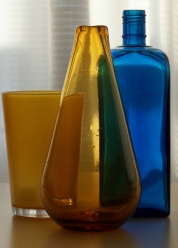|
text (dutch)
Riny Weistra
translated by
Tjerk Jonkman
|
|
About:
300 dpi, 72 dpi, EXIF and dpi, resolution, printing, 72dpi, 300dpi, dpi
and ppi, pixels, printerresolution, pixels per inch, dots per inch,
camera and megapixels (MP), dpi/ppi and photoshop
There is much confusion about dpi.
Searching with Google with the terms forum 300 dpi results in a long string of questions: how is it done, I don't get it. Some people try to explain it, others meddle with this. The end is usually an enormous confusion of tongues. For all these bewildered people I have written this article. What happened before you can
read
here.
DPI is a confusing conception. When it concerns the inking of prints, it means DOTS PER INCH. But it is used too for PIXELS PER INCH. Though in that case one should speak of
PPI. But to make it even more confusing the term DPI is also used for PIXELS PER
INCH. Alas. A better notation for PIXELS PER INCH would be: px/inch. Or when we
convert to centimeters: px/cm. More: a
copy of an article
that earlier was on alpenglowimaging.com.
What is DOTS PER INCH?
Read here
1 inch = 2,54 cm, 1 cm = 0,39 inch
The dpi-value in the EXIF is meaningless. It is a fictitious number.
(A photo has no dpi, only pixels)
You can find the properties of your digital photos in a photo editing program, but also in the Windows Explorer. Do a rightclick on your file and next: Properties > Summary > Advanced. These properties are called the EXIF-data. Or short EXIF. In that row also a value for dpi is given, f.e. the number 72, 180, 300 etc. This is a number without any meaning, it is an invented number! A box (field) has to be filled in, so every producer simply invents a number. Don't get confused, it is nonsense. A photofile in a camera or (stored at) a computer has no size in centimeters or inches. So no ppi (or dpi). Such a file only has a subdivision, a resolution, in pixels. From the moment you are going to print there is the matter of size, given in inches or centimeters. Only then you can speak of pixels per inch (ppi, regrettably ususally called dpi).
See fifth paragraph of:
www.scantips.com/no72dpib.html#6
The resolution of a photo is expressed in Pixels (w x h)
The resolution of a print is expressed in Pixels per Inch
Resolution is a confusing conception
RESOLUTION is just like DPI a confusing term. It has several meanings. So watch out in which contexts DPI and RESOLUTION are used.
Dpi and photoshop
Dpi (actually ppi) is only important in case of printing. When you open a picture in Photoshop a dpi-number is mentioned. Donít pay attention to it. It doesnít tell you anything, you can change it in any number you want, it doesnít change anything of the picture. But beware: you have to uncheck the resample-box! Resampling means calculating a new
number of pixels. The moment resampling is off, you can change the dpi-number, the according printing-measure is given. It also works the other way around: change the printing-measure, the dpi-number of the picture will be shown.
How to calculate the dpi without software
Of course it is possible to calculate the dpi without Photoshop: pixels (height or width) divided by inches (heigth or width) is dpi.
An image on internet or a monitorscreen is not 72 dpi
A computerscreen (monitorscreen) is nowadays usually adjusted at 1024 x 768 pixels (this is called screenresolution). And when a picture on your screen is shown, then on each screenpixel is one picturepixel. Or actually just the reverse: every pixel of the image takes up the space of exactly one pixel of the screen. For example: a photo sized 512 pixels wide on a 1024 pixels-wide screen, covers half of that screen in width. It doesnít matter how large your monitorscreen is measured in centimeters or inches. A photo on a screen has only a 'size' in pixels. Of course you can try to find out with a ruler how many centimeters or inches that very picture on that very moment measures on your screen. But it is useless, your videosystem works with pixels only, not with centimeters or inches. So forget this 72 dpi.
More information:
www.scantips.com/no72dpi.html
What gave birth to the 72 dpi-myth?
The dpi (px/inch) of the PRESENTATION of an image on the screen is identical to the dpi of that screen. So on a screen of 72 dpi the presentation of that image is 72 dpi too. But the image itself is not 72 dpi. Put it more strongly:
such an image hasnít any dpi, only pixels. And as computerscreens formerly often had a resolution of 72 dpi, the misunderstanding arose that an image on a screen or on a website is always 72 dpi. But on a screen of for instance 100 dpi is an image on that moment 100 dpi too. On a screen of 96 dpi is the image 96 dpi etc. etc.
But only on the moment of presentation. The image itself has no dpi, but only pixels.
Explanation: The image is reproduced 1 to 1 (pixel on pixel), thatís why it has the same dpi (ppi) as the screen on which it is shown on that particular moment.
To determine the dpi (px/inch) of a screen:
Calculate the screenresolution (width x height in pixels). Determine the size of your screen in one direction (width or height). Now divide the pixels (in width or height) by inches (in width or height).
More: see previous and next paragraph.
Photoshop and Save for the Web (72 dpi? No)
Why does Photoshop indicate 72 dpi at Save for the Web? Simply because a box has to be filled in. But it is a fictitious number. Other software for example mention 96 dpi or 120 dpi.
See:
www.scantips.com/no72dpib.html#6
The picture on the right side of this page was 1063 pixels wide. I wanted it to fit in the right column, so I resampled it with Irfanview to 178 pixels wide. With Photoshop you can do this by means of Save for the Web. (With this, other changes are possible too, but are of no importance for this argumentation.)
When you have saved this picture and you open it again in Photoshop, the imagesize-box will show you 72 dpi. When you uncheck resample, you will be able to change the dpi according to your wish, the pixelsize remains the same, and the printsize changes. The reverse is possible too: change the printsize, the dpi changes. But this printsize and the dpi have no significance if you want to put this picture on the web. Itís only the pixelsize that matters.
That this picture is not 72 dpi, is visible when you look at Windows Explorer or Windows Viewer. The Exif (properties box) mentions here 96 dpi. So Photoshop invents 72 dpi, and Windows thinks: letís make it 96 dpi.
What printers have problems with, is that people get pictures from internet to have them printed. In case of the picture on this page: Suppose I want to print the picture of 178 pixels wide at the size of 10 cm wide (= 3,9 inches). Then the dpi is 45,2. This is of course far too low. The difference with 300 is also too big for resampling (see below the paragraphs Dpi and Printing and Numeric Example).
But my dear printers: this picture wasnít and never has been 72 dpi as you always maintain. This picture has far too few pixels for a good print at the size of 10 cm, and far too low dpi at 10 cm (45), but never has been 72
dpi.
(Addition: When I want to print this picture of 178 x 248 pixels at the size of 6,28 by 8,25 cm (= 2,47 by 3,44 inch), then the dpi is exactly 72.)
Dpi and printing (300 dpi and printed matter)
For printing is usually 300 dpi required. With Photoshop you can calculate if your picture conforms to this requirement (uncheck the resampe box!). When this is not the case (too little dpi), you put the dpi at 300, check the resample box, and your picture is ready to be printed. However pay attention: when your picture is too far under 300 dpi, you might try to resample it to 300, but what you get then is a inferior print. Too much difference is not allowed. So consult with your printer. It is also better to resample a picture that is far higher than 300 dpi. This has advantages for the printer, moreover you wonít be able to see the difference with the naked eye when printed.
300 dpi? No! Pixels, thats's what it's all about
An example:
A 4 MP camera produces (ratio 3:2) photos of about (rounded) 2300 x 1500 pixels.
When made with a Nikon camera, you read: 2300 x 1500 pixels, 300 dpi.
When made with a Canon camera, you read 72 dpi instead.
(With the newest Canon cameras itís usually 180 dpi.)
These photos are to be sent to the printshop, and both are to be printed in the same size.
The Nikon photo will be accepted because it is 300 dpi, which is according to the demands of the printshop. The Canon photo will be returned because of its resolution, which is too low, and its too bad quality to print. According to the prinshop, this photo doesnít meet the requirements because the dpi is far too low to get a good print.
MADNESS! THIS IS NO EXCEPTION, THIS IS THE RULE
This is because one doesnít understand what dpi/ppi really is. That photo by Canon has exactly the same quality as the one by Nikon (perhaps it is even better, f.e. a sharper, better exposure, less noise) and can be printed in the same size as that one by Nikon. Because the Canon photo has the same
number of pixels. Only Canon chose at random the number 72 to be put in the dpi-box, while Nikon chose number 300 in the same way. Kodak took 230. Another manufacturer chose 180, etc.
But such a number has no meaning whatsoever. You can rub or cross this number out and replace it by another number (as it is a digital data, you can of course not rub or cross it out really, you must do this by means of Photoshop).
And when you change in case of the Canon photo the number 72 into 300 in Photoshop (or Irfanview) (uncheck the resample-box!), you save this photo and send it to the printer, he/she will say: 300 dpi, perfect photo.
This while the quality of the photo hasntí been changed at all! Same exposure, same number of pixels, nothing has changed. Only the number of 72 has been changed into 300. I think the printer (or his preparer) could have done this quicker himself.
Another example:
A 4 MP camera, ratio 3:2, produces a photo of about 2300 x 1500 px.
A 5 MP, ratio 3:2, produces a photo of 2600 x 1700 px.
Suppose the first photo comes from a Nikon camera, than you read: 2300 x 1500 px, 300 dpi.
The second one is from a Canon camera, here the info mentions: 2600 x 1700 px, 72 dpi.
Both must be printed at the same size.
The first photo will be accepted by the printer, the second one will be returned because of its too low resolution.
This is absurd, because it is just the reverse: the second photo has a higher
resolution.
The resolution of a (not yet printed) photo is the pixelsize (see third paragraph on this page).
NEXT PARAGRAPH: WHAT CAN GO WRONG!
See also:
What Print Shops Really Want:
www.rideau-info.com/photos/printshop.html
Ken Watson applies to people from the printing-shops, and says STOP DOING THIS, ask fot the number of pixels you need, and not for the dpi.
Changing the DPI:
www.rideau-info.com/photos/changedpi.html
Ken Watson tells us here: If a printer still asks for a photo with so much dpi instead for a photo with so many pixels, dontí try to explain the way it works, give them what they ask for, change the dpi of the photo in whatever number they want, 300 or it doesnít matter what, as long as you donít resample. The dpi-number is meaningless, and a change of that number doesnít alter your photo.
Deliverspecification for printed matter 300 dpi. What can go wrong
Photos intended for printing must be delivered in 300 dpi (deliverspecification). It happens that in practice this is required too even when the printsize isnít known yet. Actually ridiculous (see preceding paragraphs) but it happens regularly. This is no problem when the customer knows that it is possible to uncheck resampling in Photoshop (or Irfanview). If the customer doesnít know this, things can go pretty wrong.
For example:
1. Pictures made with my 4 MP Kodak Camera, are loaded in Photoshop as follows:
2304 x 1536 px, 230 dpi, and (of course because of that 230 dpi) 10,017 x 6,678 inch.
2. I change this to 300 dpi and I donít know that I must uncheck resampling, so I get:
3005 x 2003 px, 300 dpi, printingsize stays 10,017 x 6,678 inch.
3. Suppose the printingsize must be 8 inches wide (of course the 300 dpi must not be changed), then you get:
2400 x 1600 px, 300 dpi, 8 x 5,333 inch.
This means that at first there has been a resampling upwards at 3005 x 2003 pixels. After this resampling downwards to 2400 x 1600 pixels. But resampling was quite unnecessary. Quite a pity to to spoil your beautiful photos in this way!
So: When the printsize is not yet known and the printer requires that you must deliver your photos in 300 dpi, uncheck the resample-box in Photoshop (or Irfanview)! In that case nothing can go wrong.
Read also: Ken Watson - The Horrible DPI Mistake, on his page The Myth of DPI
www.rideau-info.com/photos/mythdpi.html
Wrong: Deliver photos at 300 Dpi. (This is what you read at the sites of the greater part of the printshops, above you can read that because of this you will get bad prints.)
Printers should say: Photos must be delivered with enough pixels, so that they can be printed at minimally 300 dpi (actually ppi, px/inch).
Numeric example
I own a 4 MP camera.
When Iím taking pictures, ratio 4:3, the picture will be 2304 x 1728 pixels, and W x H in pixels is then 3.981.312 = (rounded off upwards) 4 MP.
In ratio 3:2 they will be 2304 x 1536 = 3.538.944 = (rounded off) 3,5 MP.
I mostly take pictures in ratio 3:2. Suppose I want a print of size 15 x 10 inch, then the dpi will be: 2304/15 = 153,6 (or when I calculate it with the height: 1536/10 = 153,6).
This is far below 300 dpi. I could resample, but the difference between 153 and 300 is too much, the picture will be of a very bad quality.
When I start from 300 dpi, I can make the following calculation: 2304/300= 7,68 en 1536/300= 5,12. So a picture of (rounded off) 8 x 5 inch is the maximun printingsize for the photos made with my camera, starting with a dpi of 300.
In case of calculating this for your own photos: when a little below 300 dpi for a certain printing-size, you can resample with Photoshop. When far above 300 dpi, you have to resample downwards.
Schematically:
∑ divide pixels by inches, is the outcome > or exactly 300, you get a good print
∑ divide pixels by inches, is the outcome < 300, you have to add pixels (resamplen)
∑ divide pixels by 300, and youíll get the maximum printsize in inches
∑ divide pixels by centimeters, is the outcome > or exactly 118, you get a good print
∑ divide pixels by centimeters, is the outcome < 118, you have to add pixels
∑ divide pixels by 118, and youíll get the maximum printsize in centimeters
But once more: the dpi must not be too low, for in that case resampling has no use any more. Youíll get a very bad picture (where is the limit, I donít know exactly, so consult your printer).
And now for something else:
1. What you read above is the official story, the thing you have to reckon with as printers start from these. But as a matter of fact it is no more than a directive. At the beginning the norm was 240, but a broader margin was wanted, after rounding off upwards the norm was fixed at 300 dpi.
Yet there are more factors which determine a good print, for example the quality of your cameralens. You can read more about this at Ken Rockwellís site:
www.kenrockwell.com/tech/mpmyth.htm
2. Ken Watson thinks nowadays 200 dpi is sufficient for printing. On his site
www.rideau-info.com/photos
youíll find among others the following articles: What Print Shops Really Want, and Changing the DPI.
DPI as DOTS PER INCH (as distinct from PIXELS PER INCH), are the small inkdots (per inch) that come on the paper during the printing-procedure. The DPI (dots/inch) must be larger than the DPI/PPI (pixels/inch), otherwise the result will be a bad print. An example: A print has 300 pixels per inch and 1200 dots per inch. In this case each pixel has the average of 4 (ink)dots.
Back to second paragraph
Printing at home and printerresolution
Dpi (dots per inch)
At home you are usually printing with an inkjetprinter. When printing a colour print it puts on each pixel several dots (inkdrops) (see previous paragraph). Some printers have a higher dpi than other ones, and you tend to think: the higher the better. This neednít always be true. Other technical aspects of a printer are no less determining for the quality of the print. For example the way colours are mixed, the space between and the size of the inkdrops, and much more. Instead of relying on the dpi better read the reviews at the websites which are known as reliable.
Dpi (pixels per inch)
When printing at home there is in general no need to adjust the dpi (pixels per inch) (as described in the paragraph Dpi and Printed Matter). Although it is sensible to make an estimation at what size your picture approximately (maximal) can be printed. A homeprinter usually produces still good prints at 200 dpi (pixels per inch). You can make a proof in order to see if the result is satisfactory. If not, make a smaller print, or raise the dpi (ppi) with, for example, Photoshop or Irfanview. See for explanation elsewhere on this page.
Numeric example:
200 dpi (ppi) = 200 pixels per inch = about 80 pixels per cm. So a print of 15 by 10 cm has to be 1200 by 800 pixels minimally. If not, resample as described elsewhere on this page.
A useful trick to be able to know quickly how large a picture roughly can be printed in
centimeters is: divide pixels by 100.
Explanation: 100 pixels per cm = 254 pixels per inch = 254 dpi (ppi).
Dpi and scanning
An example: you want to print a photo sized 4 by 5 inch the same size. Than you have to scan it at 300 dpi. If you wish to print it at 8 by 10, youíll have to scan at 600 dpi, the print will be 300 dpi. The question is, can your device manage it, it makes great demands on the memory. But essentially this is the way it has to be done. More info:
www.scantips.com (scroll
down)
Camera and megapixels (MP)
The MP of a compactcamera is usually based on the production of photoís of 4:3.
(Also see paragraph Numeric Example as mentioned above.) My camera is specifically called a 4 MP camera. A photo of 4:3 (adjusted at best quality or highest resolution) has 2304 x 1728 pixels = (rounded off) 4.000.000 pixels = 4 MP.
(The camera can also be adjusted at a lower resolution, in that case you get a picture with fewer pixels in both width and height.)
When I set the camera at 3:2, in the highest resolution, the picture will have 2304 x 1536 pixels = (rounded off) 3.500.000 = 3,5 MP. This picture is of the same quality, the same resolution as the picture of 4:3! The number of pixels changes, caused by ratio and not by quality! Width remains the same (2304 pixels), but height changes from 1728 into 1536, so in all there are fewer pixels.
So if you know the MP, you can calculate the number of pixels.
4x x 3x = MP. So 12 x square is MP.
When for instance you own a compactcamera of 5 MP, then the procedure is as follows: 12 x square = 5.000.000. Calcultate the x and you will see that the picture will be (approximately) 2582 x 1936 pixels.
(Explanation: divide 5.000.000 by 12, extract the root, multiply this number with respectively 4 and 3, and youíve got W x H in pixels.)
So by means of the MP of a camera you are able to calculate the printsize of your pictures. First calculate the number of pixels with the formula 12 x square. Then divide by 118, and you have the maximum printsize in centimeters (for inches: divide by 300). (See scheme in the paragraph Numeric Example.)
With a reflexcamera the MP-indication usually gives the number of pixels of a photo ratio 3:2. So f.e. a 6 MP camera, adjusted at the highest resolution, produces photoís of approximately 3000 x 2000 pixels. (Same calculation as with compactcamera, but now 6 x square = 6.000.000)
Advantages and disadvantages of a camera with a high MP
Is a camera with a high MP better than a camera with a low MP?
No, the quality of the picture has to do with other factors, not with the number of pixels.
The advantage of a camera with a high MP
The higher the MP, the more pixels a photo has, the larger this photo can be printed. This especially is important when you frequently make crops. The number of pixels decreases, through which the maximum printingsize gets smaller (compared with the original photo).
(But for very large prints the MP can even be lower, as these photos are viewed at a very great distance.)
The disadvantage of a camera with a high MP
The files are getting bigger (in KB or MB). So your memory card will earlier be full, storage at the computer requires much room, sending by mail often is not possible in the original resolution.
(It is often possible to set the camera in a lower resolution, a lower MP. Donít mix this up with the JPEG-compression, this certainly has to do with the quality of the picture!)
You can work it out for yourself now with the information as given in the previous paragraph: a 6 MP camera will be amply sufficient for most people. And as with printing at the customary size a 4 MP or 5 MP camera meets too with the demands.
Link: The Megapixel Myth - www.kenrockwell.com/tech/mpmyth.htm
Just like many other people I got confused when I wanted to have pictures printed and I was told that I had to deliver them at 300 dpi. The pictures I had made with my Kodak-camera were 230 dpi, at least this was mentioned in the Exif-data. Asking questions about the meaning of that number in photostores resulted in rambling stories. Making inquiries at Kodak Nederland gave the following result: one didnít believe that a dpi-number was mentioned in the Exif, because a stored picture has no dpi, I was told. When they found out that really 230 dpi was mentioned in the Exif of the Kodak-pictures, they found this odd. I searched on internet for the meaning of dpi. With the information I gathered I couldnít explain the dpi of my pictures. And that may be right, for on an internet-forum I read the only plausible explanation: it is a fictitious number, some number has to be filled in. I think that this ďboxĒ is inserted in view of the printing of photos. But as long as printing is out of the question, that fictitious number is senseless and confusing. I take it ill of camera-manufacturers that they omit to supply information about this. The same applies to books about photography. Hardly ever youĒll find this explanation there. Thatís why I have put this information on internet.
Back to first paragraph
Dpi in the education for the graphical sector
From various sides I learn that in the schooling for the graphical sector the misunderstandings about dpi, as described above, are still taught (in The Netherlands, but also in most other countries). It turns out to be very difficult to convince the graduates form these educational institutions (who find themselves in the printing trade) that they are mistaken. They certainly find it hard to accept this from an outsider.
Illustrative is the reaction on a forum by a former pupil of a graphical school:
OK, so I understand that at the graphical school everything has been explained incorrectly. This seems rather strange to me. This canít be wrong, Iíve got this from school. It was drillled into our heads.
This attitude Iím afraid will only change when someone inside the trade group realizes that something is amiss on this point in the printing trade and starts to act to bring about a change in the schooling. Maybe this will happen only when the sector realizes that it profits by it: less frustration in the contacts with clients, less mistakes, less loss of time. We will see.
|
|

photo - r.weistra
Pictures of Gronngen
Holland
(The Netherlands)

Pictures
Groningen

Pictures
Groningen

Pictures Groningen

Pictures Groningen

Pictures Groningen 
Pictures Groningen

Pictures Groningen

Pictures Groningen

Pictures Groningen

Pictures
Groningen
|